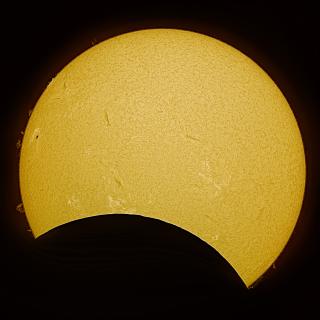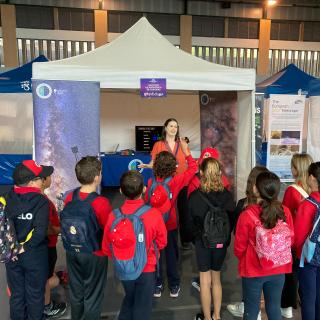The European Fund for Regional Development (FEDER) is an financial instrument of the European Commission whose purpose is to strengthen the economic and social cohesion in the European Union correcting the imbalances among its regions. From Monday 30th April until 10th May people can visit, without charge, the itinerant exhibition “FEDER looks at the sky” in the Casa Salazar, in Santa Cruz de La Palma, which makes a visual presentation of the projects of the Instituto de Astrofísica de Canarias which have been financed with these funds, notably the Gran Telescopio Canarias (GTCO) which is, like the Canary Island Observatories themselves, considered a Singular Scientific and Technical Infrastructure. This exhibition, organized by the Instituto de Astrofísica de Canarias (IAC), Grantecan S.A. and the Department of Finance of the Government of the Canaries, is also supported by the Cabildo of La Palma and the Severo Ochoa Programme of Excellence.
In addition, in acompaniment to this exhibition, and thanks to funding from the Department of the Tresury of the Canary Goverment there will be a set of Open Days, with free visits to the GTC during each Sunday in May. The transport to the Roque de los Muchachos Observatory (Garafía, La Palma) is covered by the organizers, from Santa Cruz de La Palma, and from Los Llanos de Aridane. To make one of these visits you will need to register beforehand at the website of Adastralapalma.
Telescope construction
Thanks to FEDER funding it was possible to build telescopes, for example the GTC the biggest optical/infrared telescope in the world, and the Quijote experiment, which studies the Cosmic Microwave Background radiation. Also FEDER funds have financed projects for telescopes which will be built in the comng years: the New Robotic Telescope (NRT, Liverpool-2) (¿NO DEBE SER LIVERPOOL 5 ROMA 2?) which will be the largest and most advanced robotic, remote-controlled telescope in its class; the European Solar Telescope (EST) which will be the largest research infrastructure in Europe in the field of ground-based solar physics, and the Large Size Telescope (LST) of the CTA-North telescope array, which will be dedicated to the study of gamma rays, highly energetic radiation generated in the most violent phenomena in the Universe.
Astronomical instrumentation
The FEDER funds have also permitted the development of various instruments which are operating on the telescopes. Fort he GTC they have cofinanced OSIRIS and EMIR. The first is a visible light spectrograph which can obtain information from a field on the sky which is thousands of times smaller than that of the human eye, but with an angular resolution a hundred times bigger. EMIR works at infrared wavelengths, and can operate in real time a system of slits to observe up to 50 objects at at time. The FEDER funds have also be used for other instruments such as MEGARA, a high resolution spectrograph for the visible range, CANARICAM, which observes in the mid-infrared, the system of Adaptive Optics for the GTC which reduces the distortion produced in the images by the Earth’s atmosphere and a system of artificial stars which, using laser technology, forms bright points on the sky to act as references for use with the Adaptive Optics system.
Funding from FEDER has also been valuable in supporting the development of other instruments: HARMONI, one of the first light scientific instruments for the future super-telescope the Extremly Large Telescope (ELT) in Chile, AOLI, an adaptive optics system and camera which will give the highest resolution on the sky ever achieved in astrophysics, SOPHI, the instrument for the Solar Orbiter mission of the European Space Agency, and WEAVE , which will give the William Herschel Telescope of the Iaac Newton Group of Telescopes the technology needed to produce spectroscopic surveys of the sky.
Installations and equipment
The European Funds for Regional Development also have been of value in our campaign to produce the continuous observations needed to guarantee the quality of the Canary sky. They have contributed to the development of a System of Centralized Data Storage and of intensive computation for Astronomical Research. This system facilitates, for the scientists, the work of processing and storing the information obtained in astronomical observations.
In addition FEDER has supported the development and the consolidation of the line of cryogenics in the Deparment of Mechanics of the IAC, which is basic to the development of new instruments which need refrigeration to function correctly. This Department ahs also used the FEDER funds to develop its CAD and CAE Hall (Computer Assisted Design and Computer Assisted Engineering).
The funding has also been of value as an incentive for the development of projects in the Electronics Laboratory of the IAC, among which is the Imaging and Sensors Laboratory (LISA).
FEDER funds have been used to make improvements in the La Palma node of the Spanish Supercomputer Network (RES), and infrastructure connecting 13 supercomputers in order to offer high performance for the scientific community. It has also been a key element in the implementation of the Strategy for Intelligent Specialization for the Canaries (RIS3) which has made the archipelago a meeting point for scientific, training, and business activities in Africa, Europe and America.
Without the help of the European Fund for Regional Development it would not have been possible to carry out the measure taken to facilitate the Access and to improve the Canary Island Observatories.
The IAC's actions in the CTA project are financed by the project "The four Large Size Telescopes (LST) of the CTA-North in the ORM" reference ESFRI-2017-IAC-12 of the Ministry of Science, Innovation and Universities, 85% co-financed with European Regional Development funds (FEDER) of the Operational Programme for Intelligent Growth 2014-2020. This project is co-financed with Canary Islands Development Funds (FDCAN) from the Cabildo Insular de la Palma.
The Observatories of the Instituto de Astrofísica de Canarias (IAC) and the Gran Telescopio Canarias (GTC) are part of the network of Singular Scientific and Technical Infrastructures of Spain.



